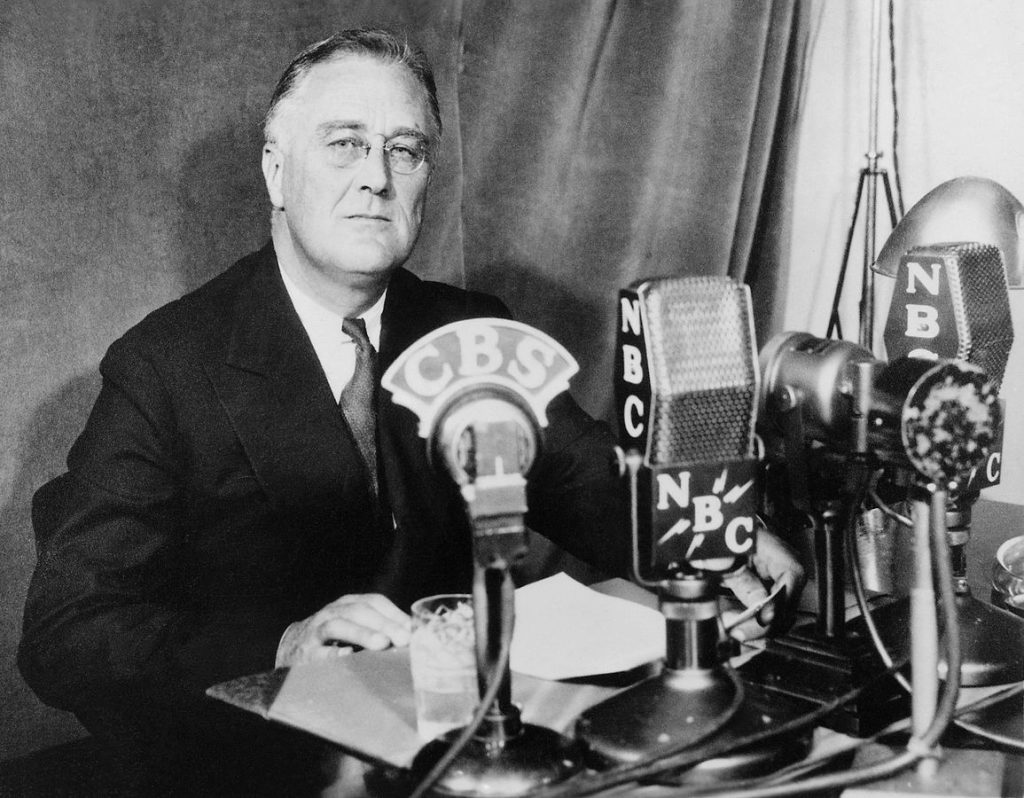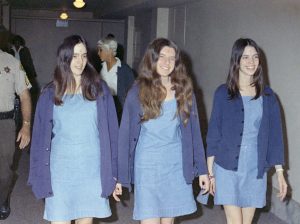BOOSH…In an instant the United States naval base, Pearl Harbor, was attacked by Japanese military planes; hundreds of U.S. military personnel, as well as U.S. civilians, were killed. The country was shaken to its core, even President Franklin D. Roosevelt. President Roosevelt wasted no time on that afternoon and evening of December 7, 1941. Within mere hours, President Roosevelt established a War Council meeting to address his most trusted officials, informing them that entering the war had now become a reality. After that War Council meeting, President Roosevelt was in dire need of rest, to recover from the news of the bombing, so much so that President Roosevelt required his otolaryngologist to treat his inflamed and swollen nasal passages. Even though the attack was clearly taking its toll on FDR, he only rested for a short period of time before calling three more meetings, which lasted through the night and into the morning of December 8, 1941.1
After the meetings with the President’s staff in the morning of December 8, Roosevelt addressed Congress in one of the most historical speeches in American history, declaring that the day that Japanese attacked Pearl Harbor would be a “date which will live in infamy.”2 Then, President Roosevelt leveraged the infamous attack to justify a declaration of war on Japan to avenge the fallen. In response to Roosevelt’s overwhelming passion, as well as the country’s anger and vulnerability, the majority of Congress passed the declaration of war on Japan. With the passing of the declaration of war, it was made clear that the request for war was limited to Japan because their military had acted alone in the bombing. Roosevelt, however, really wanted to go to war with not only Japan, but also with Germany and its ally Italy. So, in order to rage war on Hitler and all of his allies, Roosevelt had to put pressure on Hitler using one of his official radio addresses to the public. These official radio addresses were known as “Fireside Chats,” which Roosevelt had begun at the beginning of his presidency in 1933. In these radio “chats,” President Roosevelt provided comforting and informative words to the American public so that they could have some reassurance. Two days after the attack on Pearl Harbor, Roosevelt gave his highly anticipated “Fireside Chat,” where he stated that “Germany and Italy, regardless of any formal declaration of war, consider themselves at war with the United States at this moment, just as much as they considered themselves at war with Britain or Russia.”3 Such a statement immensely added to Hitler’s reasons for finally declaring war on the U.S. on December 11, 1941.

Prior to the bombing of Pearl Harbor, almost all of President Roosevelt’s “Fireside Chats” were about how the U.S. needed to stay out of the war. So, one might think that American citizens would be angered at President Roosevelt’s flip to engaging in the war. But in fact, a large majority of American citizens stood behind Roosevelt in engaging in the war. Thus, when the United States officially entered the war, everyone, even the people who claimed to support isolationism, found some relief in the fact that the country was taking steps to avenge their people. Though, all reliefs could not be quelled with the action of war, due to the simple fact that a majority of U.S. citizens still felt high levels of vulnerability because of their “enemy,” the Japanese-Americans, being their next-door neighbors. Now, Japanese-Americans had long been a disliked and unwelcomed people long before the Japanese attack on Pearl Harbor. Their coming to America and taking jobs from the already existing U.S. citizens had long stirred zenophobic anxieties. 4 So now with a Japanese attack having taken place on U.S. soil, those anxieties rose even higher against the Japanese-Americans. Many of these Japanese-Americans were intuitive enough to realize that resentment was coming, and went to great lengths to either reassure their fellow U.S. citizens or hide from them. For example, Saburo Kido, the president of the Japanese American Citizens League (JACL), took the initiative to send a telegram to President Roosevelt informing him that “Japanese-Americans are stunned and horrified at…[the] unwarranted attack by Japan upon American soil, our country. We want to convey to you that we unequivocally condemn Japan for this unprecedented breach of good faith.”5 Kido even pledged that the JACL would do everything possible to assist in “the defense of [their] land against this attack [and relinquish their] fullest cooperation” to President Roosevelt and the United States. Although Kido and the JACL relayed some reassurance to President Roosevelt, they were not successful in squashing the rumors about Japanese spies in America. Somehow newspapers got a hold of “evidence” proving that Japanese spies were to blame for Pearl Harbor, and many citizens believed them without a doubt, because they wanted so badly to see the Japanese-Americans as the enemy. Such negative sentiment was fueled by newspapers that ran headlines like “Slap the Jap Rat,” and consequently drove Japanese-Americans into hiding by claiming that they were of another Asian ancestry, so that they could avoid as much hatred as possible.
Quickly, hiding became ineffective for Japanese-Americans, because citizens who were not Japanese began to apply pressure on the government to ensure their safety by placing regulations on Japanese-Americans. The first step in these regulations was a 9:00 P.M. curfew for “enemy aliens,” which was a legal way of saying Japanese-Americans. It was enacted on February 4, 1942. This major regulation on Japanese-Americans, however, was not satisfying enough to West Coast citizens and political officials who felt more vulnerable due to their close proximity to Japan and their higher Japanese-American populations. So, where do they go from here? They went to President Roosevelt to demand that he take action to protect the majority of U.S. citizens by pushing the Japanese-Americans two-hundred miles inland, for the “safety” of all.6 For awhile, President Roosevelt chose to evade the pressures of the West Coast, and he even avoided his advisers, because he recognized that the status of Japanese-Americans was a sensitive situation; he had to balance safety and rights. Did the safety of one group of citizens require that another group of citizens had to sacrifice their rights? Unfortunately, as war tensions escalated so did the ideas for regulating Japanese-Americans. In fact, the ideas even called for their relocation. This idea of relocation suggested that Japanese-Americans had to be moved inland and be monitored by military authorities. Again, President Roosevelt realized the injustice in the action of relocating all Japanese-Americans, but he became overwhelmed by plea after plea from U.S. citizens and government advisers about how the relocation was a “military necessity” that would protect the country from “Japanese spies.”7 So, like any human being, President Roosevelt gave into the pressures of war, and chose to sacrifice Japanese-American rights by signing Executive Order 9066 on February 19, 1942.

In short, Executive Order 9066 authorized the “War Department to designate certain land as military areas and handing it the right to evacuate from those areas anyone it deemed a threat,” though the order would go on to only be enforced against Japanese-Americans on the West Coast.8 Furthermore, February 19 was only the dreadful day that President Roosevelt signed Executive Order 9066. It wasn’t until March 9, 1942, when the order began to shatter thousands of loyal Japanese-American lives.9 The evacuation began with “Civilian Exclusion Orders” posted in all areas with Americans of Japanese ancestry, detailing what to do as far as belongings and where to go. Ultimately, the Japanese-Americans cooperated because they felt it was the simplest way to reassure the country that they were no threat. Though, just because they cooperated didn’t mean that the U.S. military went easy on them. In fact, one of the harsh requirements on all Japanese-Americans was for them to sell their property because it was deemed that they would no longer need their property. From here, the Japanese-Americans would live in military internment camps that were located in unirrigated deserts that left them to suffer in scorching heat or icy cold weather. Ideally, these camps were built to allow the internees to go about their lives working and learning, but just in a military and barbed wire area. Now, there were no gas chambers or crematories, but internees were still abused and occasionally killed under mysterious circumstances. So, no, these camps were nothing like the German Death Camps, or even German concentration camps that existed at this same time; but they were nonetheless a nightmare for Japanese-Americans, and a complete violation of their rights as citizens of the United States. 10

As the war was drawing to a close, and progressing in the United State’s favor, President Roosevelt recognized that there was no longer any justification for holding Japanese-Americans behind barbed wire. So, in December of 1944, President Roosevelt rescinded Executive Order 9066 and announced that all Japanese-Americans could return home on January 2, 1945. After Roosevelt’s announcement, all camps were officially closed in early 1946, because the government wanted to ensure all of the internee’s loyalty to the United States.11 Now, just because President Roosevelt announced that all Japanese-Americans were freed doesn’t mean that they were immediately loved. In fact, they were discriminated against even more. Part of this discrimination was due to the strong emotions aroused by the war. People felt that they were still justified in their discrimination of Japanese-Americans because of the creation of the internment camps. President Roosevelt might have been able to sooth the people faster with a Fireside Chat or by encouraging the reintegration of Japanese-Americans, but he died from a stroke on April 12, 1945. So, with the loss of President Roosevelt, the Japanese-Americans were left to fend for themselves to regain trust from their fellow countrymen. Consequently, the Japanese-Americans would have to wait forty-three years for resentment to reach a level where they would receive an official apology from their government, and twenty-thousand-dollar compensation for the life-scarring internment. But no amount of money or apologies can ever undo the horrific actions the United States government conducted in one of its darkest hour.12
- Paul Burtness and Warren Ober, “Provocation and Angst: FDR, Japan, Pearl Harbor, and the Entry into War in the Pacific,” Hawaiian Journal of History 51, (2017): 108-110. ↵
- Greg Robinson, By Order of The President: FDR and the Internment of Japanese Americans (Cambridge, Mass: Harvard University Press, 2001), 74. ↵
- Paul Burtness and Warren Ober, “Provocation and Angst: FDR, Japan, Pearl Harbor, and the Entry into War in the Pacific,” Hawaiian Journal of History 51, (2017): 110. ↵
- John F. Wukovits, Internment of Japanese Americans (Detroit: Lucent Books, 2013), 15-17. ↵
- John F. Wukovits, Internment of Japanese Americans (Detroit: Lucent Books, 2013), 21. ↵
- John F. Wukovits, Internment of Japanese Americans (Detroit: Lucent Books, 2013), 20-29. ↵
- John F. Wukovits, Internment of Japanese-Americans (Detroit: Lucent Books, 2013), 30-32. ↵
- John F. Wukovits, Internment of Japanese-Americans (Detroit: Lucent Books, 2013), 32. ↵
- “Executive Order 9066 passed in the US,” History Today 67, no. 2 (2017): 9. ↵
- John F. Wukovits, Internment of Japanese-Americans (Detroit: Lucent Books, 2013), 34-40. ↵
- John F. Wukovits, Internment of Japanese Americans (Detroit: Lucent Books, 2013), 96-97. ↵
- Joyce Moss and George Wilson, Literature and Its Times: Profiles of 300 Notable Literacy Works and the Historical Events that Influenced Them (Detroit: Gale, 1997), 137-143, http://link.galegroup.com/apps/doc/CX2875100248/GVRL?u=txshracd2556&sid=GVRL&xid=489a8828. ↵



76 comments
Pamela Callahan
President Roosevelt was truly an extraordinary leader. He was so much different than the President’s in the past. His Fireside Chats, being one example. I think it must have been a dramatic change for the people at the time to have a President who was so different, but that in the end it was very beneficial to our country and caused a world of a difference. Congrats on the nomination!
Victoria Rodriguez
The Japanese Internment Camps is a stain on America’s history. It is ugly and unfortunate that a tragedy rallied up Americans through hate and nationalism and not patriotism. I found that the images of old propaganda really helped to visualize what it was really like during that time. What would be even more interesting if added to the article, is the fact that a lot of the Japanese were even transported to central and South America causing much of the U.S propaganda to be spread through other countries.
Micaela Cruz
This was an interesting historical based article; it was fascinating to read about the aftermath after the bombing of Pearl Harbor. The use of images helped support what the author was stating throughout the article as well give a visual aid. President Roosevelt did what he could to protect the American people as well as get them to realize how important it is that we fight for our country. However, it was rather unfortunate to see the Japanese-American citizens suffer the way they did; the treatment they received from the American people was uncalled for and then for them to end up in almost similar camps that resembled the German concentration camps was frightening. Overall an excellent article.
William Rittenhouse
This was an amazing article and I think you definetley used enough information that the reader understands well. The pictures were great as well. The word choice was also really great. Overall, it deserves to be nominated and it deserves a trophy. I would nominate this article for the topic and the content. You had great content and examples. I think the content was overall great content. Overall on a scale of 1 to content I would give this article a content. Great job and good content.
Steven Hale
It is easy to try and gloss over these moments in American history. Any way you look at the internment of Japanese-American citizens, America failed in some way. Even if we try to absolve the government and FDR of responsibility by arguing that they faced enormous pressure from some citizens, people in positions of authority still went along with the internment.
Jabnel Ibarra
Often compared to the internment camps in Nazi Germany, the relocation of Japanese-Americans during World War 2 is one of the pieces of history we as Americans would prefer to forget. The duration of World War 2 marked some one of the worst acts the world has seen in the history of humanity, ones that the United States is not exempt from. Though its easy to criticize the actions of the American government in isolating Japanese citizens, it is important to remember that we are privileged with the knowledge of history and the ability to reflect on actions to know why these internment camps were immoral and wrong.
Peter Coons
Japanese, German and Italian internment is a sort of double edge sword. Yes, families were interned together. Yes, they were placed in camps and not allowed to leave. Yes, they were prisoners in their own countries for crimes they did not commit. However, as awful as internment was, it was a necessary evil. Not because of “enemy spies”, since we know that it was a logistical impossibility for there to be that many traitors in our midst, but because we had to defend them from their neighbors. The racism that boiled in the blood of so many white Americans was enough to inspire mass lynchings if the people were not separated from each other. In a way, as bad as internment was, it was the lesser evil when compared to what mob justice would do to innocent people.
Joandleroy Munoz
Awesome work! The high level of skill is truly evident in the amount of research and eloquent structure that the author had put into this article. Which in turn contributed to highlighting the significance of this dark time in American history.
J. Solis
As a pseudo historian, I absolutely loved this article. With this informative article we are enlightened to the dark past of our country, and we must learn from it so that we never make the same mistake again. My only preference would’ve been to have a picture of citizens being relocated for shock value, but otherwise, I am extremely impressed by the structure and research done by the author.
Devin Ramos
This article was very informative in telling what happened after the attack on Pearl Harbour. One thing I did not know was how much of a toll it was taking on President Roosevelt and that he had to be seen for his nasal passages. Executive order 9066 to me was wrong because these people were American citizens and the only reason they were being sent to these camps was that of their race.